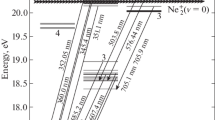Abstract
The relative intensities of the Balmer series lines of hydrogen and deuterium atoms and the Q-branch lines in the Fulcher-α band system of the H2, HD, and D2 molecules were measured. These lines were emitted by non-equilibrium plasma surrounded by the cylindrical channel of an additional molybdenum electrode located between the cathode and anode of glow (in the deuterium with a minor hydrogen impurity) and arc (in a mixture of D2, H2, and Ne in comparable quantities) discharges at pressures of 6–8 Torr and current densities of 0.4 and 8.5–17 A/cm2, respectively. The measured intensity ratios and gas temperature were used for the estimation of the relative particle densities of the H2, HD, and D2 molecules in the framework of the simple models of the excitation of atoms (models 1a and 1b for the high and low values of dissociation degrees, respectively) and the rovibronic levels of isotopic molecules (model 2). The results obtained by means of models 1a and 2 were in a significant contradiction, whereas the data obtained with the use of models 1b and 2 coincided within error bars. The good agreement between two spectroscopic techniques based on two independent theoretical models and two independent sets of experimental data showed that the techniques proposed are promising for the determination of the isotopic composition of molecules in lowpressure hydrogen-deuterium plasma at least in the case of a low dissociation degree of molecules.
Similar content being viewed by others
References
B. P. Lavrov and A. S. Zhukov, Russ. J. Phys. Chem. B 8, 807 (2014).
B. P. Lavrov and V. P. Prosikhin, Opt. Spectrosc. 64, 298 (1988).
T. V. Kirbyat’eva, B. P. Lavrov, V. N. Ostrovskii, M. V. Tyutchev, and V. I. Ustimov, Opt. Spectrosc. 52, 21 (1982).
B. P. Lavrov and L. L. Pozdeev, Opt. Spectrosc. 66, 479 (1989).
B. P. Lavrov, A. S. Melnikov, M. Kaening, and J. Roepcke, Phys. Rev. E 59, 3526 (1999).
A. S. Zhukov and B. P. Lavrov, in Conference Abstracts of the International Student Conference “Science and Progress,” St.-Petersburg (SPb. State Univ., St.-Petersburg, 2013), p.82.
M. D. Gabovich, Physics and Engineering of Plasma Ion Sources (Atomizdat, Moscow, 1972) [in Russian].
B. P. Lavrov, A. S. Mikhailov, and I. S. Umrikhin, J. Opt. Technol. 78, 180 (2011).
B. P. Lavrov and I. S. Umrikhin, arXiv:physics.chem-ph/1112.2277v1 (2011).
B. P. Lavrov and L. P. Shishatskaya, Sov. J. Opt. Technol., 46, 692 (1979).
B. P. Lavrov, M. Kaening, V. L. Ovtchinnikov, and J. Roepcke, in Proceedings of the International Workshop on Frontiers in Low Temperature Plasma Diagnostics II (Bad Honnef, Germany, 1997), p.169.
W. L. Wiese and J. R. Fuhr, J. Phys. Chem. Ref. Data 38, 565 (2009).
R. S. Freund, J. A. Schiavone, and H. M. Crosswhite, J. Phys. Chem. Ref. Data 14, 235 (1985).
G. N. Polyakova, A. I. Ranyuk, and V. F. Erko, Sov. Phys. JETP 46, 1117 (1977).
B. P. Lavrov and A. S. Mel’nikov, Opt. Spectrosc. 75, 676 (1993).
B. P. Lavrov and A. S. Mel’nikov, Opt. Spectrosc. 79, 842 (1995).
A. V. Phelps, Plasma Sources Sci. Technol. 20, 043001 (2011).
K. Levenberg, Quart. Appl. Math. 2, 164 (1944).
D. Marquardt, SIAM J. Appl. Math. 11, 431 (1963).
N. L. Johnson and F. C. Leone, Statistics and Experimental Design in Engineering and the Physical Sciences (Wiley, New York, 1964).
B. P. Lavrov, Opt. Spectrosc. 48, 375 (1980).
The Hydrogen Molecule Wavelength Tables of Gerhard Heinrich Dieke, Ed. by H. M. Crosswhite (Wiley-Interscience, New York, 1972).
G. H. Dieke and R. W. Blue, Phys. Rev. 47, 261 (1935).
K. P. Huber and G. Herzberg, Molecular Spectra and Molecular Structure. IV. Constants of Diatomic Molecules (Van Nostrand Reinhold, New York, 1979).
B. P. Lavrov, B. H. Ostrovskii, and V. K. Ustimov, Sov. Tech. Phys. 25, 1213 (1980).
A. I. Drachev and B. P. Lavrov, High Temp. 26, 129 (1988).
M. Osiac, B. P. Lavrov, and J. Roepcke, J. Quant. Spectrosc. Rad. Transfer 74, 471 (2002).
Author information
Authors and Affiliations
Corresponding author
Additional information
Original Russian Text © A.S. Zhukov, B.P. Lavrov, 2016, published in Khimicheskaya Fizika, 2016, Vol. 35, No. 2, pp. 8–17.
Rights and permissions
About this article
Cite this article
Zhukov, A.S., Lavrov, B.P. Spectroscopic determination of the relative particle densities of H2, HD, and D2 Molecules in non-equilibrium hydrogen–deuterium plasma: II. Experimental verification. Russ. J. Phys. Chem. B 10, 5–14 (2016). https://doi.org/10.1134/S1990793116010231
Received:
Published:
Issue Date:
DOI: https://doi.org/10.1134/S1990793116010231



